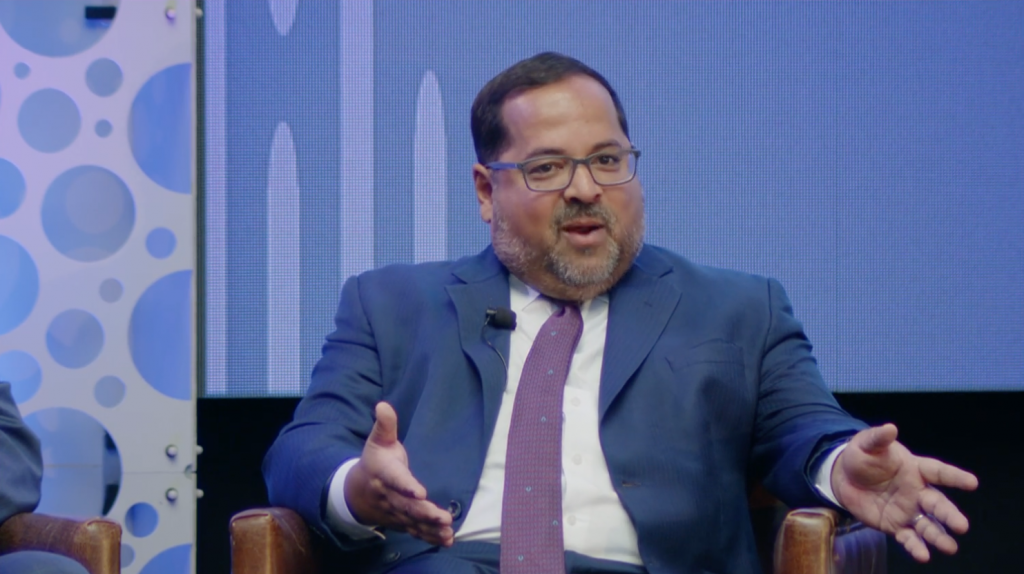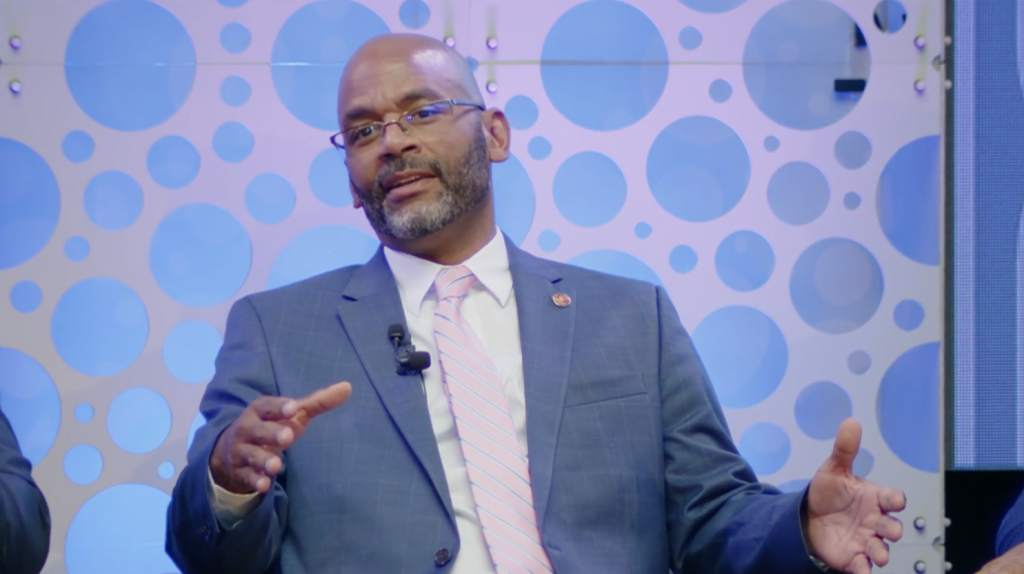Regulator’s roundtable: Leveraging AI to enhance grid reliability and manage costs

This is a recap of a session from AiDASH Evolve 2024
Summary:
- State and federal regulators work with utilities as they explore technologies to enhance grid resilience in a way that benefits ratepayers.
- Regulators are increasingly using data and analytics to shepherd the investments utilities are making, and then measure the return from those programs.
- Collaboration between regulators and utilities fosters a proactive approach to modernizing infrastructure, meeting today’s energy demands — and preparing for tomorrow’s.
During a roundtable discussion at AiDASH Evolve 2024 in New Orleans, state commissioners and customer advocates came together to talk about ways regulation is encouraging famously conservative utilities to invest in technologies that help balance their reliability, costs, and resilience.
Moderated by Angela Navarro, President, ALN Policy & Law, the roundtable comprised:
- Erik M. Helland, Chair, Iowa Utilities Commission
- Davante Lewis, Commissioner, Louisiana Public Service Commission
- De’Keither Stamps, Commissioner, Mississippi Public Service Commission
- Neil Chatterjee, Former Commissioner and Chairman, Federal Energy Regulatory Commission (FERC)
Navarro kicked off the discussion by stating the importance of regulators’ role in the utility industry. “[Regulators’] foundational principle is ensuring that power is provided in a safe, reliable, and affordable manner,” she said. “And we’re going to talk about the intersection between that.”
Regulators leverage technology to enhance grid reliability and resilience
“I have seen firsthand the benefit to consumers, to the economy, and to the environment from enabling regulations that promote competition, that promote innovation,” said Chatterjee. “In this space, in particular, I think there is a huge opportunity for utilities, for energy providers, to embrace AI and technical innovation.”
Maintaining grid reliability amidst increasingly severe weather events is one of those challenges addressed by the right investments in technology. For some communities, however, reliability isn’t just a convenience — it’s essential for safety and well-being. Commissioner Lewis shared how AI-driven initiatives have strengthened grid resilience in his district, which includes many economically disadvantaged communities that face unique risks in extreme weather.

“We compared the last two storms that took a very similar path as Francine, which were Hurricane Ike and Hurricane Gustav. At both of their peaks, we saw approximately 1.2 million Louisianians without power. Because of the investments that we’ve made in resiliency and vegetation management, we peaked at only 400,000 without power [during Hurricane Francine]. And within 24 hours, we were down to only 20% being without,” Lewis explained.
These proactive investments are especially vital in areas where residents lack the resources to evacuate during debilitating storms. Lewis emphasized that, for his communities, enhanced grid resilience is crucial. “People aren’t going to be able to leave, so that recovery time has to be improved.”
The regulator’s role in driving innovation
As Commissioner Lewis’ example shows, regulators don’t just oversee utilities; they also play a crucial role in shaping how quickly and effectively they adapt to change. Lewis highlighted how in many cases, regulators need to lead the charge. “A utility is only going to move forward on what they know they may get cost recovery for what a regulator will approve,” he explained.
To that end, the Louisiana Public Service Commission (LPSC) is working with utilities to determine which grid-enhancing technologies have the highest priority and getting those projects out in front of the Department of Energy’s Loan Office. The utilities also file a monthly report on the federal grants they’re applying for, so the Commission can help review and evaluate. This collaborative approach allows regulators like Lewis to guide utilities into the future, ensuring that new technology investments align with both local needs and federal funding opportunities.

Chatterjee emphasized the importance of strong regulatory leadership, tempered with an understanding of the challenging position utilities face. He pointed out that cooperation between FERC and state regulators is essential for fostering sector-wide innovation.
At the same time, “forcing change can be a challenge because, at the end of the day, all of us have a responsibility to make sure the lights come on . . . whenever you’re talking about incorporating something new, the knee-jerk reaction is: ‘Well, hold on: What is this new technology, and what might it mean for electric reliability and affordability?’”
Reflecting on his tenure as Commission and Chairman at FERC, Chatterjee highlighted initiatives such as FERC Order 841, which removed barriers to energy storage, and FERC Order 2222, which enabled distributed energy resources to compete in wholesale markets. “We’ve got to make sure that we can keep pace with the speed of [technological] innovation,” he said, underscoring that a supportive regulatory framework is essential for progress.
Data-driven decision-making propels utility modernization
The panelists unanimously agreed on the importance of using data to inform policy for the mutual benefit of utilities and their ratepayers. Commissioner Lewis described taking a more holistic approach to decision-making, instead of looking at performance indicators like sustainability, reliability, and affordability in silos.
“If I’m looking at census tract information, where my most impoverished communities are, I can pair that with reliability data to see if I should invest more in vegetation management here, because I’m looking at historical weather patterns . . . and I know this community is not going to be able to evacuate from a hurricane. And so, when we’re looking five years from now, we can solve so many problems if we connect [those metrics] utilizing technology,” he said.

Chair Helland emphasized the importance of data for quantifying the impact of regulation. “A lot of the decisions we make are hard. They’re really difficult,” he said. “And if you can hang your hat on being able to point to the efficacy of a program because you said, ‘We applied this amount of money and we know this was the return, and it is this much more reliable or it is this much more affordable for this population,’ you can start demonstrating and measuring those programs.”
The numbers in Mississippi point to a different set of challenges. Commissioner Stamps is simultaneously facing a declining population and a grid that costs more to utilize. In response, he’s courting hyperscalers to help bridge the gap.
“With one datacenter project, we were able to negotiate a new production facility to add capacity. And through the Amazon deal and work with our energy partners, we’re putting a billion dollars into the Mississippi Delta,” he said.

Madison County, where the AWS facility is being built, was due to decommission an old gas-fired power plant, which would have forced local residents to get their power from a neighboring county. Instead, there’s a new plant going in next to the old one. The datacenter gets redundancy, ratepayers enjoy a more reliable grid, and the cost is distributed equitably.
Regulators look to innovation for a safer, more reliable grid
The roundtable highlighted how by working together, regulators and utilities are reshaping the way technology serves the energy sector.
Chatterjee drew the panel to a close with his take on the regulator’s role in this symbiotic relationship: “Regulatory policy that promotes and incentivizes investments, and gives utilities the right sort of desire and incentive to want to invest in these kinds of futuristic technologies to get ahead of risks around wildfires and vegetation management? I view that as enabling regulation, and I would hope that that would be something that federal regulators, state regulators, Republicans, Democrats, industry, and consumers could all get on board with.”
Check out more sessions and information from Evolve 2024, and reach out to see the AiDASH Platform in action!
The best collection of tools, tips, guides, and industry stories – straight to your inbox.
Subscribe to our newsletter
